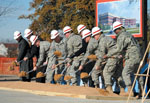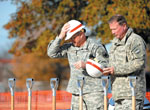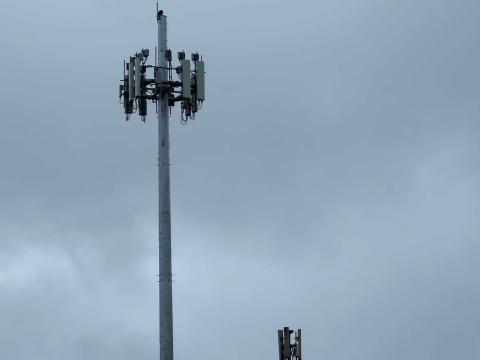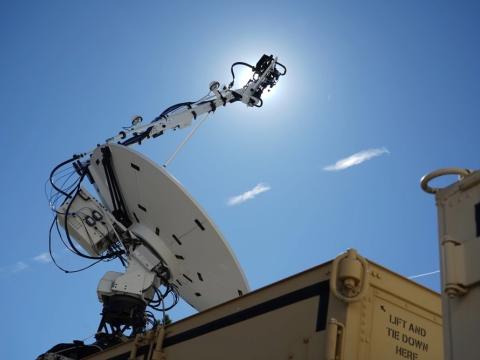Move Brings Two High-Level Organizations Into One Edifice
 |
Lt. Gen. Jack C. Stultz, USAR (4th from l), commander, U.S. Army Reserve Command (USARC), and Gen. Charles C. Campbell, USA, (5th from l), commander, U.S. Army Forces Command (FORSCOM), are flanked by other Army, state and local officials during the groundbreaking ceremony for the commands’ combined headquarters at Fort Bragg, North Carolina. |
The U.S. Army is responding to base realignment decisions by combining two major command headquarters into a single state-of-the-art facility. The physical proximity of personnel who already work closely together should enhance collaboration in the command and control of soldiers, but an emphasis on entity individuality will remain. The building itself will contain technologies that combine certain aspects of the two tenant organizations while ensuring that separate identities and capabilities are maintained when necessary.
U.S. Army Reserve Command (USARC) and U.S. Army Forces Command (FORSCOM), both currently located at
Sharing a facility is a natural fit for the two commands because they already work in close collaboration with USARC providing reserve troops for worldwide FORSCOM-directed missions as necessary. USARC evolved out of FORSCOM, which also works with active duty and National Guard soldiers. “We’re a team now, but we’ll be closer,” Phil Roper, the FORSCOM G-6 BRAC lead for the move to
Despite the combination of their headquarters, the two commands will remain distinct and separate, even using different entrances clearly marked for each entity. The structure of the leadership also will stay the same, with one FORSCOM commander and one USARC commander. The commands do not expect relationships to alter as a result of the changes. Though the two organizations involved in the move will merge facilities and in some cases capabilities, the focus during the project is not to combine FORSCOM and USARC into an integrated command.
Operations at the commands largely will remain unaltered as well, and according to reserve officials, the change will have no impact on troop strength. USARC personnel expect the change to appear seamless to soldiers and commands. The commands also foresee little change to the management of forces. Roper and USARC officials say operations should appear seamless during the move, with the effect on the government coming from efficiencies related to operations, maintenance and the transition to the
Though USARC anticipates no mandated reduction in personnel, the command is aware of the probability of losing members of the seasoned work force from both organizations. Predictions say that perhaps only one-third of civilian employees will move from their current location to
In addition to the work performed by FORSCOM, USARC and BRAC personnel in the combined headquarters project, organizations such as the Fort Bragg Director of Information Management (DOIM) and the U.S. Army Information Systems Engineering Command (ISEC) also are involved in the effort. ISEC is preparing and installing the technology services that will be present in the facility, and the DOIM will provide many of the services used by personnel inhabiting the facility, such as e-mail exchange, network access and telephones. For ISEC, handling a major headquarters relocation is a typical job, but placing two command headquarters in the same building is a new experience. To allow for potential changes that may occur, ISEC is engineering the infrastructure so the building’s interior is flexible enough for various personnel configurations.
Brian Devine, senior systems engineer for the enterprise systems engineering directorate at ISEC, explains that the main complexity comes from handling the differences in needs between the two commands, developing a good design to fit both organizations’ requirements and accommodating the discrepancies. He shares that moving even one headquarters of a three- or four-star command is an involved process because high-level commands rely on many systems for day-to-day operations, all of which must remain functional during transitions so missions can continue unimpeded. With two organizations moving simultaneously, ISEC personnel must deal with two chains of command, all of their people and all of their technologies.
Devine’s colleague, John Pitkin, the project leader for ISEC’s portion of the combined headquarters project, agrees that moving two distinct commands into a single facility makes this transition more complex than others. He shares that the two organizations have slightly different requirements, but that they have agreed to share certain capabilities, such as a single state-of-the-art audiovisual (A/V) system as well as the local area networks inside the building. Much of the technology will be logically separated but physically the same.
 |
Lt. Gen. Jack C. Stultz, USAR (l), commander, USARC, and Gen. Charles C. Campbell, USA, commander, FORSCOM, put on their hard hats during the ground-breaking ceremony for the command’s combined headquarters building at Fort Bragg. |
Sharing network capabilities is not new for the two commands. According to Roper, the USARC headquarters currently at
ISEC personnel are planning for the combined headquarters to incorporate many cutting-edge technologies such as the high-definition A/V network that uses an Internet protocol (IP)-based system. Devine says that, “Converging the A/V network onto an IP network is a significant difference from what we’ve done in the past.” The combined headquarters will have as part of that A/V capability digital signage to replace the hard, physical posters used in the current facilities. The automated displays on flat-panel screens will reduce cumbersome easels and enable better graphics. The control room for that technology will have shared-use software that personnel can use to change messages as often as they want.
Placing voice, video and data over IP is the direction in which ISEC is trying to take new facilities to match up with Army plans. However, designers realize that funding might prevent them from realizing all their goals. BRAC funding generally only covers installation of current capabilities, so new functions and technologies often need money from non-BRAC sources, such as the Army commands.
When the move is complete, both commands should save funds through the combination of their capabilities. The A/V network will be centered in one room, reducing costs from running two separate centers. Roper explains that the commands will experience cost and resource benefits by consolidating their information technology. He shares that information technology costs never really go down because a need and a desire always exist for more capabilities, but efficiencies will increase. The commands will combine several information technology requirements during the move; however because of USARC’s requirements to connect to civilian soldiers and FORSCOM’s need to support all active soldiers, differences will remain. “We can’t just take the two entities and combine them because of those different requirements,” Roper states.
Many of the technologies going into the headquarters are geared toward C2, including the A/V system. Each command will have its own operations center and other C2 functions such as Global Command and Control System, ultrahigh frequency satellite communications, the Defense Red Switch Network, physical office automation and additional applications. The commands occupying the new facility demand more C2 capabilities than other organizations ISEC has worked with in the past, and ISEC is creating functions with that in mind. Pitkin explains, “The networks we’re building are a little more robust and have more fault tolerance than you would find in a typical office building.” The increase in complexity includes creating a separate operations center for each command and installing the high-tech A/V systems in those centers.
In addition to the challenge of merging two commands into one facility, the combined headquarters project presents other unique issues because some USARC operations and technologies differ from those of the active duty Army. For example, part of the transition involves moving USARC’s worldwide data center, which performs many of the functions a DOIM normally would carry out. Because the reserves have personnel at non-Army locations and spread out worldwide, USARC’s environment is different. Services that the Fort Bragg DOIM normally would provide to a tenant will be unnecessary because USARC will handle the work through its worldwide data center. The center also offers some custom services for reserve personnel.
The Army Reserve has its own network—ARNET—managed out of the data center in the same way that the Defense Information Systems Agency manages the nonsecure Internet protocol network, or NIPRNET. Pitkin says that makes ISEC’s job more complex because USARC has a different type of wide area network and infrastructure that must be supported from
Despite some uncommon obstacles personnel involved with the project face in the initial merging of the commands into a single building, Roper says he sees no major challenges posed by the collocation and shares that there is excitement about the move and new capabilities. In addition to the benefits expected for USARC and FORSCOM, the combined headquarters offers advantages to the nonmilitary population in
WEB RESOURCES




Comments